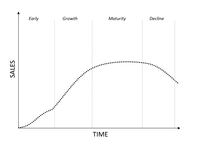Will you sustain it? Is the past comparable to the future?
Thoughts about how to validate a company’s growth
Whether you are an entrepreneur or not, I want you to be prepared when it comes to the discussion about the sustainable growth of your firm.
I’ve been doing mainly financial due diligence. So, I have been analyzing firms from a financial standpoint for the last years. Large companies as well as small firms and startups. Most due diligence assignments cover this topic: corroborate a company’s business plan. The validation can be done from a commercial or financial perspective. For the latter, the validation of future growth is quantitatively driven. For example: is there an explanation for these figures? How do they tie back to historical financials? Yet, there is no guarantee that growth will come as modeled.
Today, I am sharing my thoughts about a company’s growth. It’s no recipe or guide on how to approach an engagement, it is rather a collection of thoughts to keep in mind.
Top-line vs. bottom-line
It is important to differentiate between top-line and bottom-line growth. And everything that happens between top and bottom. Fixed costs can grow at a lower stage compared to revenue and to their fixed nature. Revenue can grow at a slower rate compared to EBIT(DA). For example, if the drivers are internal efficiency improvements. That way, the company increases its EBIT(DA) by reducing its costs. So, determining which growth rates to use for which line items is already an important first step.
Historical data
How many years are we looking at? In a due diligence, the last three to five years are analyzed. Is this enough to make meaningful statements about a company’s future growth? It depends on the company, the industry and the business model. Taking into account the availability of data is also important.
Life cycle consideration
This chart shows the different stages. And it also shows that growth depends on the company’s current stage. It is important that we understand the company’s stage. And also, to which extent this will change within the next years. For example, growth rates will likely decline for early and growth firms. But they will be stable for mature firms and negative for firms in the decline.
Industry matters
Each industry has its own drivers. Cyclical industries follow a “high growth — low growth” pattern, ups and downs.
Project-based businesses (construction, consulting firms, automotive suppliers) often follow the order book. The order book is the pipeline with future projects. It provides good visibility of how the company will do in the next year.
Key aspects
- Differentiate between top-line and bottom-line
- Take into account that your data set is limited
- Consider the current stage of a company’s life cycle
- Have a look at the company’s specific industry
Final thoughts
When it comes to estimating growth, there is no right or wrong, it all depends on the assumptions made. In this article, I shared some thoughts about a company’s growth rate. I hope these help you in your next discussion about a company’s business plan.
Get more content like this directly into your inbox and download your free finance & valuation guide (>50 pages)
